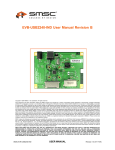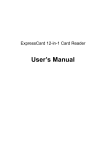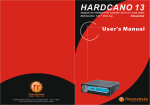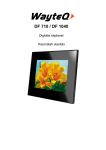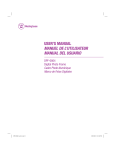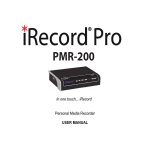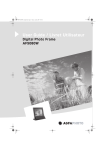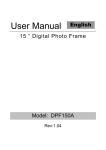Download EVB-USB2660/USB2660i Evaluation Board Revision A User Manual
Transcript
EVB-USB2660/USB2660i Evaluation Board Revision A User Manual Copyright © 2009 SMSC or its subsidiaries. All rights reserved. Circuit diagrams and other information relating to SMSC products are included as a means of illustrating typical applications. Consequently, complete information sufficient for construction purposes is not necessarily given. Although the information has been checked and is believed to be accurate, no responsibility is assumed for inaccuracies. SMSC reserves the right to make changes to specifications and product descriptions at any time without notice. Contact your local SMSC sales office to obtain the latest specifications before placing your product order. The provision of this information does not convey to the purchaser of the described semiconductor devices any licenses under any patent rights or other intellectual property rights of SMSC or others. All sales are expressly conditional on your agreement to the terms and conditions of the most recently dated version of SMSC's standard Terms of Sale Agreement dated before the date of your order (the "Terms of Sale Agreement"). The product may contain design defects or errors known as anomalies which may cause the product's functions to deviate from published specifications. Anomaly sheets are available upon request. SMSC products are not designed, intended, authorized or warranted for use in any life support or other application where product failure could cause or contribute to personal injury or severe property damage. Any and all such uses without prior written approval of an Officer of SMSC and further testing and/or modification will be fully at the risk of the customer. Copies of this document or other SMSC literature, as well as the Terms of Sale Agreement, may be obtained by visiting SMSC’s website at http://www.smsc.com. SMSC is a registered trademark of Standard Microsystems Corporation (“SMSC”). Product names and company names are the trademarks of their respective holders. SMSC makes the following part-numbered device available for purchase only by customers who are xD-Picture Card licensees: USB2660 and USB2660i. By purchasing or ordering any of such devices, Buyer represents, warrants, and agrees that Buyer is a duly licensed Licensee under an xD-Picture CardTM License Agreement with Fuji Photo Film Co., Ltd., Olympus Optical Co., Ltd., and Toshiba Corporation; and that Buyer will maintain in effect such xD-Picture Card license and will give SMSC reasonable advance notice of any termination or expiration of such xD-Picture Card license, but in no event less than five days advance notice. SMSC may discontinue making such devices available for purchase by Buyer and/or discontinue further deliveries of such devices if such xD-Picture Card license shall expire, terminate, or cease to be in force, or if Buyer is or becomes in default of such xD-Picture Card license. SMSC DISCLAIMS AND EXCLUDES ANY AND ALL WARRANTIES, INCLUDING WITHOUT LIMITATION ANY AND ALL IMPLIED WARRANTIES OF MERCHANTABILITY, FITNESS FOR A PARTICULAR PURPOSE, TITLE, AND AGAINST INFRINGEMENT AND THE LIKE, AND ANY AND ALL WARRANTIES ARISING FROM ANY COURSE OF DEALING OR USAGE OF TRADE. IN NO EVENT SHALL SMSC BE LIABLE FOR ANY DIRECT, INCIDENTAL, INDIRECT, SPECIAL, PUNITIVE, OR CONSEQUENTIAL DAMAGES; OR FOR LOST DATA, PROFITS, SAVINGS OR REVENUES OF ANY KIND; REGARDLESS OF THE FORM OF ACTION, WHETHER BASED ON CONTRACT; TORT; NEGLIGENCE OF SMSC OR OTHERS; STRICT LIABILITY; BREACH OF WARRANTY; OR OTHERWISE; WHETHER OR NOT ANY REMEDY OF BUYER IS HELD TO HAVE FAILED OF ITS ESSENTIAL PURPOSE, AND WHETHER OR NOT SMSC HAS BEEN ADVISED OF THE POSSIBILITY OF SUCH DAMAGES. SMSC EVB-USB2660/60i Revision A USER MANUAL Revision 1.0 (06-09-09) EVB-USB2660/USB2660i Evaluation Board Revision A User Manual 1 Overview The SMSC USB2660 contains an Ultra Fast USB 2.0 Hub, Flash Media Controller, and Protocol Bridge Combo. The EVB-USB2660/60i Evaluation Board demonstrates a standalone application for developers of the following applications: Flash Media Card Reader/Writer, printers, desktop and mobile PCs, consumer A/V, and flat panel displays, among others. 1.1 General Description The EVB-USB2660/60i is an evaluation and demonstration platform featuring the USB2660/60i Ultra Fast USB 2.0 Hub, Flash Media Controller, and Protocol Bridge Combo on a 4-layer RoHS compliant printed circuit board. The EVB-USB2660/60i is designed to demonstrate the unique features of this device using a low-cost PCB implementation with individual port power control for the downstream USB 2.0 ports. It is designed to support internal default configuration settings and either an external I2C EEPROM (optional) for customized configured functionality or SPI flash for customized configured functionality or for external firmware. A SPI flash device is populated on the evaluation board to provide firmware updates via USB by using the SMSC provided USBDM utility, as required. Default configuration can be changed by adding an EEPROM into the provided footprint. However, the SPI flash device has to first be removed to avoid signaling conflicts. Figure 2.1 and Figure 2.2 show the top and bottom level silk screen and copper layers. The EVB-USB2660/60i is compatible with the following: - Microsoft® Vista - Windows® XP - Windows® ME - Windows® 2k SP4 - Apple® OSx - Linux® Mass Storage Class Drivers. Schematics, Layout, and Bill of Materials are included minimizing new product development time. 1.2 Features 64-Pin QFN (RoHS compliant) package. Supports these Media Types on Media I/F1: - Secure Digital (SD2.0, HS-SD, HC-SD) - MultiMediaCardTM 4.2 - xD-Picture CardTM - Memory Stick® 1.43 - High Speed Memory StickTM - Memory Stick Pro-HGTM - Memory Stick Duo Memory Stick ProTM Supports these Media Types on Media I/F2: - Secure Digital (SD2.0, HS-SD, HC-SD) - MultiMediaCardTM 4.2 Simultaneous access to any one device on Media I/F1 and any one device on Media I/F2. Internal FET power switches for all media types; no external power FETs needed. Two USB 2.0 downstream hub ports with individual port power and over-current sense. Hi-Speed (480 Mbits/s), Full-Speed (12 Mbits/s), and Low-Speed (1.5 Mbits/s) compatible. Individual port over-current sensing. Individual port power control. Revision 1.0 (06-09-09) 2 USER MANUAL SMSC EVB-USB2660/60i Revision A EVB-USB2660/USB2660i Evaluation Board Revision A User Manual Supports internal default configuration Optionally - External - External - External Low cost 4-Layer space saving design. Self-powered operation. Operates from a single voltage (+5.0 VDC, regulated) external power supply. Single onboard +3.3 VDC regulator. +3.3 VDC power LED indicator. Activity LED indicator. Single crystal clock source. Test header locations for firmware development and debug. supports external configuration. I2C EEPROM for configuration options (optional). SPI flash for configuration options (optional). SPI flash for USB downloadable firmware (optional). SMSC EVB-USB2660/60i Revision A 3 USER MANUAL Revision 1.0 (06-09-09) EVB-USB2660/USB2660i Evaluation Board Revision A User Manual 2 Hardware Configuration 2.1 Hardware Description The EVB-USB2660/60i has one onboard regulator, which generates +3.3 VDC from an external +5 VDC regulated power supply. The USB2660/60i generates is own 1.8 VDC for internal use using onchip +1.8 VDC regulators. The internal 1.8 Volt regulator to the oscillator and PLL is turned off during suspend to minimize suspend current. The USB2660/60i consumes power from the 3.3 Volt supply. Downstream port power is distributed by a power switch, U2, that consumes power from the 5 Volt supply. 2.1.1 Port Assignment Downstream ports are numbered 2 and 3 with individual port power controllers. The port power controllers provide 5 volts of power with over-current protection to the downstream devices. Upstream and downstream port connectors have USB 2.0 compliant decoupling and a separate shield ground. 2.1.2 USB2660/60i Configuration Default: The EVB-USB2660/60i has been set up to support internal default configuration as determined by the empty state (no valid signature ID) of the SPI flash or of the EEPROM immediately after reset. When no valid EEPROM or SPI image is detected, the Vendor ID, Product ID, Language ID, and Device ID, and a few other choices are set using ROM code defaults. EEPROM Option: The EVB-USB2660/60i can load configuration from an external two-wire, I2C EEPROM U4. The EEPROM must be installed at U4, and the SPI device at U3 should be removed to enable this option. The EEPROM may be pre-programmed before installation, or it can be programmed with the USB host using the provided SMSC USBDM application. This option allows access to all of the configuration registers and ID strings for the USB2660/60i device for detailed functional analysis and exercise as desired. The EVB-USB2660/60i is compatible with I2C EEPROMs from several manufacturers. The memory capacity must be at least 512 bytes. SPI Option: The EVB-USB2660/60i can load configuration from an external SPI flash memory device at U3 only when the SPI flash is supplying external ROM code and the external code specifies this mode. The memory must be programmed with the USB host using the interface and programming utility supplied by SMSC, or by programming the SPI device in-situ, or by programming the SPI externally and then installing it at U3 to enable the SPI option. This option allows access to all of the configuration registers and ID strings for the USB2660/60i device for detailed functional analysis and exercise as desired. The EVB-USB2660/60i is compatible with SPI flash memory devices from several manufacturers. The SPI flash capacity must be at least 128 kilobytes. 2.1.3 Powered State LED An optional LED, D1, indicates when +5 VDC and +3.3 VDC power are present. 2.1.4 Activity LED An optional LED, D2, indicates when the USB2660/60i is active, as defined by firmware. Revision 1.0 (06-09-09) 4 USER MANUAL SMSC EVB-USB2660/60i Revision A EVB-USB2660/USB2660i Evaluation Board Revision A User Manual 2.1.5 Media Interface 1 The USB2660/60i supports a wide array of devices. Media Interface 1 accommodates all of the media types supported through the use of three media socket connectors. Adapters may be needed for some form factors. J8 supports SD media up to the specification limit of 4 bits wide. It also supports MMC media up to the specification 2.0 of 8 bits wide. J9 supports MS, MS Pro, MS Duo, and MS Pro-HG media at up to the specification limit of 8 bits wide. J10 supports xD-Picture Card media. Since these connectors are all on the same media bus, only one device is allowed to be inserted into any of these media socket connectors at one time for the Media Interface 1. A device may be inserted into the media interface 2 connector (J7) and simultaneously accessed while a single device is inserted and being accessed in Media Interface 1. 2.1.6 Media Interface 2 Media Interface 2 accommodates all of the SD and MMC media types supported through the use of the media socket connectors at J7. Adapters may be needed for some form factors. 2.1.7 Connector Description The EVB-USB2660/60i has a set of standard USB style connectors, one of type B for the upstream port and two of type A for downstream ports. It also has a standard set of media storage style connectors, which supports popular flash media formats from the xD-Picture Card (xD), Memory Stick (MS), Secure Digital (SD), and MultiMediaCard (MMC) families. Power is supplied via a 2.0 mm power jack. Table 2.1 lists all of the connectors. For more details on the pinout of the connectors please see the schematic. Table 2.1 Connector Description 2.1.8 CONNECTOR TYPE DESCRIPTION J1 USB B Upstream Port J2 USB A Downstream Port 3 J3 USB A Downstream Port 2 J4 Power Jack 2.0mm +5 VDC Power Supply J5 Header GPIO Test - DNP J6 Header SPI Test - DNP J7 SD/MMC4.0 SD/MMC I/F #2 J8 SD/MMC4.0 SD/MMC I/F #1 J9 MS/MS Duo/MS Pro-HG MS I/F J10 xD xD I/F Layout Considerations The EVB-USB2660/60i is designed on four PCB layers: two signal layers and two supply layers. The PCB layer stack is shown in Table 2.2. All signals are routed on top and bottom layers. Internal layers are ground and power. Note that the differential signals from the USB2660/60i match the upstream and downstream port placement, and that the media I/F signals flow easily to their destination connectors simplifying routing of critical signals. Table 2.2 PCB layer stack Component Side Solder mask SMSC EVB-USB2660/60i Revision A 5 USER MANUAL Revision 1.0 (06-09-09) EVB-USB2660/USB2660i Evaluation Board Revision A User Manual Table 2.2 PCB layer stack Layer 1 1.9 - 2.8 mil, finished Pre-preg 4.25 mil, +/- 0.25 mil FR-4 Layer 2 1.3 mil (nominal) Core ~45 mil FR-4 Layer 3 1.3 mil (nominal) Pre-preg 4.25 mil, +/- 0.25 mil FR-4 Layer 4 1.9 - 2.8 mil, finished Solder mask Solder Side The component side top layer is shown in Figure 2.1 with silk screen information to identify component locations. Revision 1.0 (06-09-09) 6 USER MANUAL SMSC EVB-USB2660/60i Revision A EVB-USB2660/USB2660i Evaluation Board Revision A User Manual Figure 2.1 EVB_USB2660/60i Top Layer - Component Side SMSC EVB-USB2660/60i Revision A 7 USER MANUAL Revision 1.0 (06-09-09) EVB-USB2660/USB2660i Evaluation Board Revision A User Manual Figure 2.2 EVB_USB2660/60i Bottom Layer - Solder Side Revision 1.0 (06-09-09) 8 USER MANUAL SMSC EVB-USB2660/60i Revision A Mouser Electronics Related Product Links 886-EVB-USB2660 - SMSC EVB-USB2660









